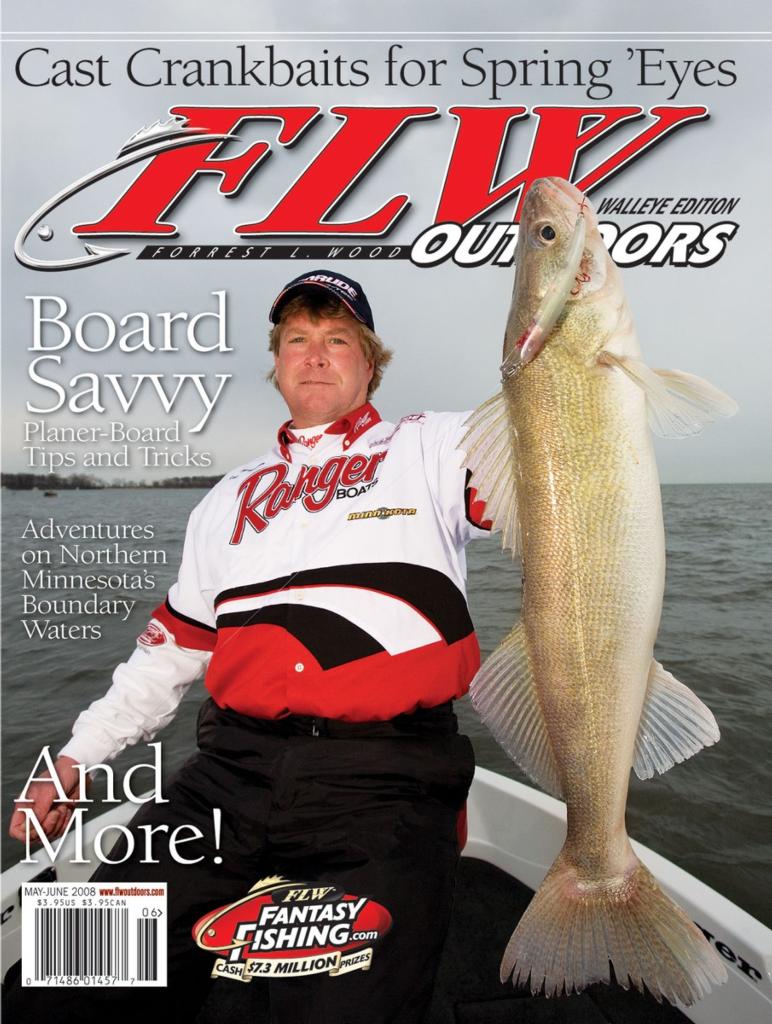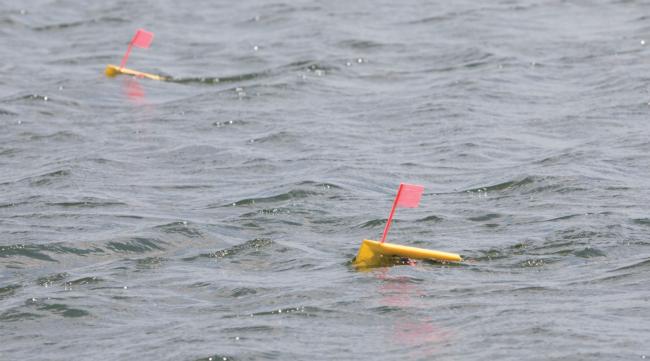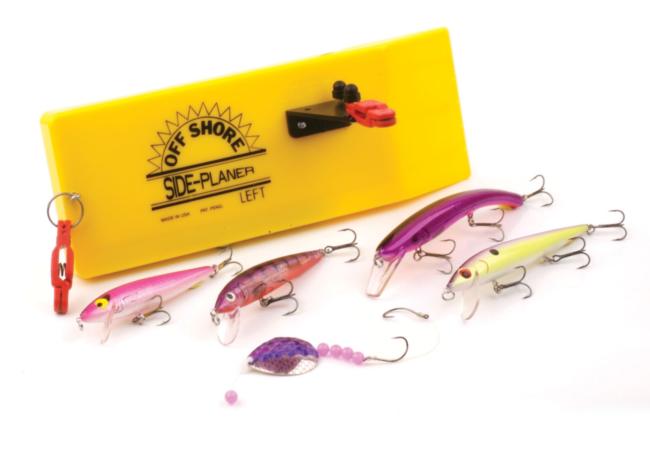Board savvy
Become a master troller with planer boards

Some of the most feared professional walleye anglers on the Wal-Mart FLW Walleye Tour often share one common denominator – they have mastered the art of trolling. More often than not, tournaments held on the Great Lakes are won by trolling. The Great Lakes, however, aren’t the only places where savvy trollers can steal the show. From rivers and reservoirs to natural lakes, trolling is an incorporated part of many of the best walleye anglers’ repertoires.
Some anglers mistakenly believe there isn’t much to trolling except driving around with lines dragging behind the boat. Believing this stereotype will result in getting burned. The best trollers hustle all day long and learn to identify factors, taking in information that many recreational anglers may miss. They are masters at reading and deploying planer boards, effectively straining every last walleye from a section of water. And even if trolling isn’t what attracts the press on game day, many of the most consistent anglers use a trolling program to break down water and log sonar data at some point in a tournament.
When we think of some of the best trollers in the game, these anglers all have a knack for being extremely explosive. These master trollers gather information all day, making adjustments to further fine-tune the presentation. When everything is right – the right lure, the right speed, the right direction, in front of the right pod of fish – the rest is history. When everything is clicking, the catching often happens fast, and this tendency for the best trollers to unlock the code of the day is what makes them so dangerous.
Keep it changing
To unlock the code each day takes constant experimentation. Troll guru Bill Ortiz of Richland Center, Wis., has made a few dollars with his trolling rods and is regarded as one of the best trollers in the game. Ortiz believes many anglers make the mistake of putting all of their eggs in one basket. Case in point, Ortiz will seldom run all of his lures in the same window when trolling open water for suspended fish. Say for example, most of the fish are coming out of 10 feet of water on the inside boards. Ortiz stressed it is still important to keep trying higher or lower as conditions change throughout the day. This is a work in progress. What works in the morning during the first hour might be cold two hours later, so experimentation is crucial throughout the day.
Specific lures and colors get the same treatment. “Don’t change every line to that one bait,” Ortiz explained. “Keep experimenting with other color patterns and baits so you can keep up with the changes as they occur.”
Factors like visibility or cloud cover may change throughout the day, so the best trollers remain flexible. The mood of the fish may change as well. During most tournament situations, the professional angler and the co-angler can use a combined four rods (check local regulations). Running two or three rods in the right zone with the right bait will result in catching all of the fish needed, but one or two lines should  always be reserved for experimentation.
always be reserved for experimentation.
On board with current
Almost all open-water and basin trolling incorporates the use of in-line planer boards. Planer boards provide the obvious benefit of spreading out lines to the sides of the boat, essentially covering a wider swath of water, but this advantage is just scratching the surface. The best trollers can use planer boards to read current, and this understanding of current is what separates the men from the boys. Usually, but not always, walleyes are swimming against the current. In massive water like any of the Great Lakes, the current can be strong and obvious, always present but possibly changing direction or intensity throughout the day. Large natural lakes or reservoirs may present a current that may be more wind-driven or unpredictable.
To read current with planer boards, it is crucial to use at least two boards out each side of the boat. Use duplicate pairs of rods for precision. The forward rods, for example, should be calibrated with the same line, the same distance from rod tip to the board, and the same angle in the rod holder. Rig the next pair of rods in the exact same manner and so on.
The ability to read and decipher current can only be mastered by using the exact same spread out each side of the boat. When the boat is trolling directly into or with the current, the boards will appear even, and both sides of the spread will look visually identical. They will be the same distance from the boat, have the same distance between boards, and everything will be in the right place. If the spread begins to lag on one side or doesn’t appear aligned, turn the boat until the spread again straightens out.
“There are times when clipping the spread crosscurrent will cause some erratic action in the lure that may trigger following fish,” Ortiz said. “Usually a pattern will emerge that will relate somehow with the current direction and the trolling direction. Most of the time, however, trolling into the current is most productive, and we are able to stay aligned by closely watching the boards.”
Many anglers agree wave action on the planer boards can impart an erratic, triggering action to both crankbaits and harnesses. The surging and stalling given to a lure as the boards rise and fall through chop can also explain some of the effectiveness of planer boards. Too much wind, however, can work against the troller by making the lures ineffective. Whenever trolling heavy seas, experiment to determine how erratic the fish want the lures that particular day.
“When the fish are really hot, we might even troll in a fashion that may cause the boards to actually jump right out of the water, hitting waves to give the lures a lot of speeding up and slowing down,” Ortiz said. “There’s lots of movement, and this is a trigger. There are also situations where the fish just don’t want a lot of wild movements, and we have to dampen the action on the lures as much as possible by trying to stay in the troughs of the waves. Running the trough is often necessary in real strong winds but just might also be the ticket with colder water temperatures early in the season or after severe fronts, despite wind velocity.”
A board sinking back from the weight of a fish is one obvious indicator the pattern of the day is being unlocked. The other indicator or clue for the troll-master happens after the fish is in the net.
The position of the lure in the fish’s maw can give the angler even deeper clues. Is the lure swallowed, barely hanging on the tip of the lip, or sideways in the fish’s mouth? Fish barely hanging by one tail hook on the tip of the top jaw or fish snagged outside of the mouth might be indicators the fish are not aggressive. They may indicate slower trolling speeds or some minor surges and stalls are necessary. Or they could mean the exact opposite. Wussy bites can sometimes be cranked up into savage hits by increasing the speed. In the end, anglers take what they can get, and the best tip is to use an extremely sharp hook to snip that following shadow nonchalantly knocking at the back of the bait. Other times, there is some control in the sense that better strikes and more secure hookups can come by making adjustments with speed and lure movement.
The higher percentage
 Ortiz has often found he can hook up a higher percentage of nipping walleyes on planer boards by manning the boards and physically dropping the board with the bite back toward the fish before sweeping it forward, setting the hook.
Ortiz has often found he can hook up a higher percentage of nipping walleyes on planer boards by manning the boards and physically dropping the board with the bite back toward the fish before sweeping it forward, setting the hook.
“This is crucial at times with harnesses,” Ortiz stressed. “Often, we need to let the fish just hang and suck on that crawler, and (then we need to) give the harness to the fish.”
To watch for the initial pickup when pulling harnesses on boards, strike indicators like Tattle Flags are an option on Off Shore Tackle Co. planer boards that are almost a necessity.
“The flag will just start to tap, and we can physically drop the board back toward the fish by either using the clicker or turning the boat toward the board,” Ortiz said. “Setting the hook is a matter of physically sweeping the rod hard to cause the planer board to zip ahead across the water, making hard contact with the fish.”
Once boards start popping and walleyes start snapping, a complex spread of planer boards can begin to resemble a three-ring circus if people in the boat don’t have a routine down. Often, Ortiz finds himself preaching this drill every day to his new recruits during a tournament. He often controls the speed and direction of the boat by using a kicker motor with tiller steering, and he will usually position his co-angler on the bow of the boat using the stand-up seat once a fish hits.
The drill is simple: Ortiz picks up the rod and hands it to the co-angler. The co-angler reels the planer board to the boat. With multiple boards, this begins to get more complicated. If the outside board on the forward-most rod is getting reeled in, the inside board gets laid back at an angle that puts the rod tip toward the motor or out the back of the boat. The clicker is used to shoot the inside board back out farther behind the boat.
Once the inside board is back far enough where the fish on the outside can get brought through the maze without tangling, the inside reel is engaged to cause the board to again sweep to the side of the boat. After the outside board and fish are in, the inside board is switched to the outside. This works, assuming the fish can be skied on top of the water directly behind the board.
Fish hooked crooked in the mouth or outside of the mouth may come in behind the boat at unpredictable angles. Larger fish may require a reduction in speed, which may allow the fish to dip back down. Whenever possible, control the speed and boat direction to keep the fight on top. Don’t let the fish dig down below the boat because this will result in more tangles and a better chance of a hard surge or run that might just tear a hook free. It’s good to see the wake and wide-open walleye jaws behind the board. Another helpful tip to remember is by skiing the fish behind the boat, it can actually be physically seen how well the fish is hooked. This tidbit of information is important in telling how much pressure to put on the fish to get it into the boat.
Once the board gets reeled up to the boat, Ortiz simply instructs his co-angler to quickly reel the board into his hands. This should be constant and smooth. There’s no time for a dangling or swinging board to be giving fish slack. Once Ortiz has board in hand, Off Shore clips and snaps make removing it a breeze even in the roughest water. Once the board is removed, he keeps his fingers on the line to maintain constant tension, again no slack. The co-angler is then instructed to reel slowly until Ortiz lets go of the line with his fingers, never giving the fish enough slack to dip down below the waves. The fish is then reeled into the net.
The nets for this kind of operation usually have extremely long handles for nabbing fish that are being skied up behind the boat. Many of the Beckman Net Co. trolling nets, for example, that many pros use have handles that extend out to 9 feet.
Using planer boards effectively can elevate many trolling programs. Anglers who incorporate boards can often get more information on which to base their decision making throughout the day. Not only do in-line planer-board systems spread out additional lines and cover more water, they allow a wider range of speed and direction changes that may trigger fish. They also enable anglers to better read the water they are fishing. A little board savvy can go a long way toward making trolling much more productive.